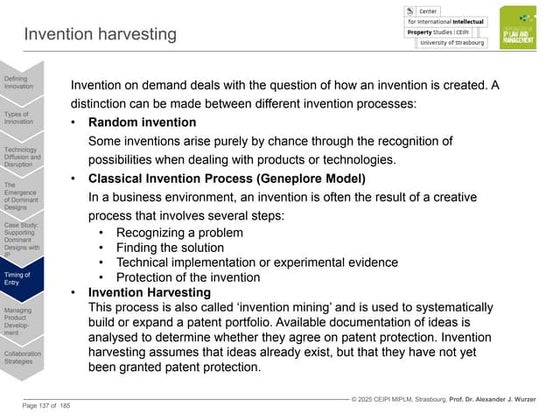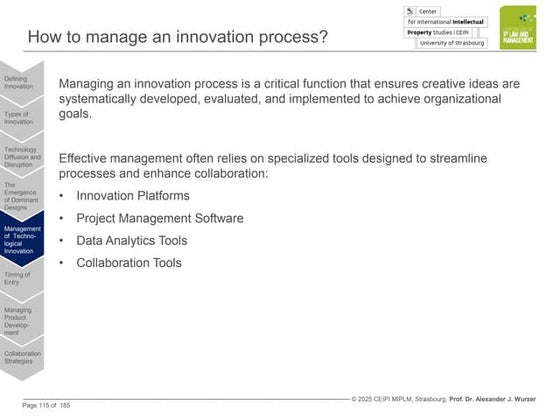library-basics python.pptx for education
Download as PPTX, PDF0 likes3 views
Python ppt
1 of 18
Download to read offline

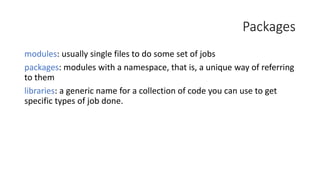
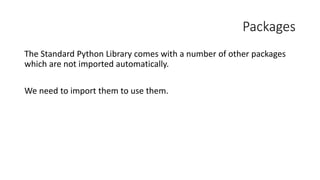



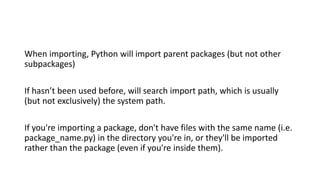



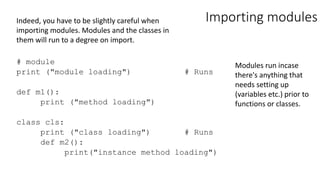




![Packages
Structure that constructs a dot delimited
namespace based around a directory
structure.
/abm
__init__.py
/general
__init__.py
agentframework.py
/models
__init__.py
model.py
The __init__.py can be empty. They allow
Python to recognise that the subdirectories are
sub-packages. You can now:
import abm.general.agentframework.Agent
etc.
The base __init__.py can also include, e.g.
__all__ = ["models", "general"]
Which means that this will work:
from abm import *
If you want it to.](https://image.slidesharecdn.com/library-basics-240605153841-f4868f88/85/library-basics-python-pptx-for-education-16-320.jpg)


Recommended
Functions_in_Python.pdf text CBSE class 12



Functions_in_Python.pdf text CBSE class 12JAYASURYANSHUPEDDAPA
╠²
In Python, a function is a reusable block of code that performs a specific task. Functions are used to break down large programs into smaller, manageable, and modular parts, improving code readability, reusability, and efficiency.
Key Aspects of Functions in Python
1. Defining a Function: Functions are defined using the def keyword, followed by the function name and parentheses ( ). Inside the parentheses, you can specify parameters if the function requires inputs.
def function_name(parameters):
# Function body
# Code to execute
2. Calling a Function: Once defined, a function can be called by its name, followed by parentheses and any required arguments.
function_name(arguments)
3. Parameters and Arguments:
ŌĆó Parameters: Variables specified in the function definition that hold the values passed to the function.
ŌĆó Arguments: Actual values passed to the function when it is called.
4. Return Statement: Functions can use a return statement to send a result back to the caller. If no return statement is used, the function will return None by default.
def add(a, b):
return a + b
result = add(5, 3) # result will be 8
5. Types of Functions:
ŌĆó Built-in Functions: Python has many built-in functions like print(), len(), and sum(), which are available by default.
ŌĆó User-Defined Functions: Functions created by the user to perform specific tasks.
6. Anonymous Functions (Lambda Functions): Python also supports lambda functions, which are small, unnamed functions defined with the lambda keyword. TheyŌĆÖre useful for short, simple operations.
square = lambda x: x * x
print(square(5)) # Output: 25
7. Function Scope: Variables defined within a function are local to that function and canŌĆÖt be accessed outside of it. This scope management helps prevent unexpected changes to variables.
Example of a Function in Python
# Define a function to calculate the area of a rectangle
def calculate_area(length, width):
area = length * width
return area
# Call the function with arguments
result = calculate_area(5, 3)
print("Area:", result) # Output: Area: 15
Benefits of Using Functions
ŌĆó Code Reusability: Functions allow you to write code once and reuse it whenever needed.
ŌĆó Modularity: Functions help to organize code into blocks, making it easier to maintain and debug.
ŌĆó Readability: Breaking down a program into functions makes it more readable and easier to understand.
Python functions are a fundamental tool in programming, allowing you to structure your code for efficiency and clarity.Functions_in_Python.pptx



Functions_in_Python.pptxkrushnaraj1
╠²
This document discusses Python functions and modules. It explains that functions are named blocks of code that perform computations, and modules allow code reuse through importing definitions from other files. It provides examples of defining functions, importing modules, and using built-in and user-defined functions. It also covers topics like function parameters, scopes, and default arguments.CLASS-11 & 12 ICT PPT Functions in Python.pptx



CLASS-11 & 12 ICT PPT Functions in Python.pptxseccoordpal
╠²
ICT skills are abilities that help you understand and operate a wide range of technology software. This can include helping users with tasks on computers, such as making video calls, searching on the internet or using a mobile device like a tablet or phone.Python modules



Python modulesSmt. Indira Gandhi College of Engineering, Navi Mumbai, Mumbai
╠²
1) A Python module allows you to organize related code into a logical group and makes the code easier to understand and use.
2) Modules are imported using import statements and can contain functions, classes, and variables that can then be accessed from other code.
3) The import process searches specific directories to locate the module file based on the module name and import path.Python Modules, executing modules as script.pptx



Python Modules, executing modules as script.pptxSingamvineela
╠²
Here are solutions to the problems:
1. import random
list1 = [1, 2, 3, 4, 5]
set1 = {1, 2, 3, 4, 5}
dict1 = {'a':1, 'b': 2, 'c':3}
file_list = ['file1', 'file2', 'file3']
print(random.choice(list1))
print(random.choice(set1))
print(random.choice(list(dict1.values())))
print(random.choice(file_list))
2. import random
list1 = [1, 2, 3, 4, 5]Pythonpresent



PythonpresentChui-Wen Chiu
╠²
Python modules allow programmers to split code into multiple files for easier maintenance. A module is simply a Python file with a .py extension. The import statement is used to include modules. Modules can be organized into packages, which are directories containing an __init__.py file. Popular third party modules like ElementTree, Psyco, EasyGUI, SQLObject, and py.test make Python even more powerful.Python import mechanism



Python import mechanismYuki Nishiwaki
╠²
This is created to straiten my understandings around import mechanism. Especially This document mentioned and summarized around site.py and pth file.
Object oriented programming in python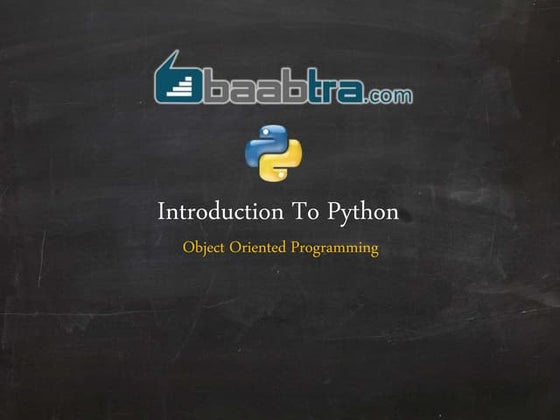



Object oriented programming in pythonbaabtra.com - No. 1 supplier of quality freshers
╠²
This document provides an introduction to object-oriented programming in Python. It discusses key concepts like classes, instances, inheritance, and modules. Classes group state and behavior together, and instances are created from classes. Methods defined inside a class have a self parameter. The __init__ method is called when an instance is created. Inheritance allows classes to extend existing classes. Modules package reusable code and data, and the import statement establishes dependencies between modules. The __name__ variable is used to determine if a file is being run directly or imported.jb_Modules_in_Python.ppt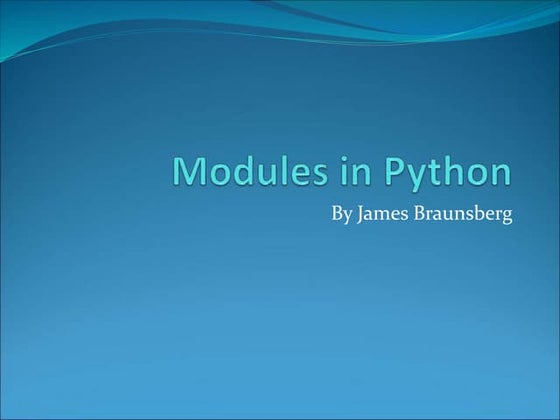



jb_Modules_in_Python.pptloliktry
╠²
Modules allow the organization of Python code into sharable files. A module is a Python file with a .py extension that contains definitions and statements. The module's contents can be imported into other modules using the import statement. Modules can contain functions, variables, classes and other code that can then be accessed using the module name. Modules are searched for using the module search path which includes the current directory and directories specified in PYTHONPATH.Intro Java Rev010



Intro Java Rev010Rich Helton
╠²
This document provides an overview of Java essentials including:
- Java addressed issues with C/C++ like inconsistent frameworks and memory management issues.
- Java introduced a common framework, garbage collection, and object oriented programming.
- The history of Java versions from 1.0 to 6.0 is summarized.
- A simple "Hello World" Java program is broken down and explained.Python modules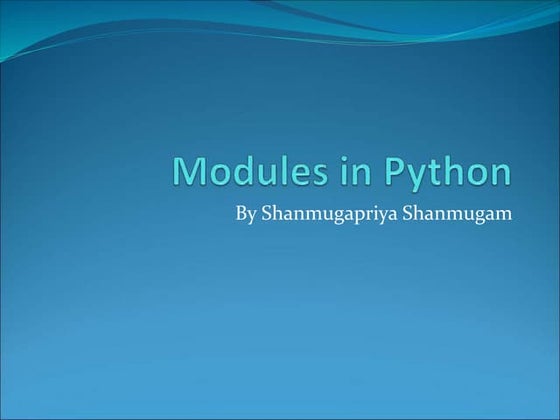



Python modulesShanmugapriya Dineshbabu
╠²
Modules allow Python code to be logically organized into files and reused across programs. A module is a Python file with a .py extension that contains functions, classes, and variables that can be imported and used by other files. The module search path determines where Python looks for modules, and modules can import other modules to reuse their code. Packages are groups of modules that make up reusable components in Python applications.Python for Beginners



Python for BeginnersDrRShaliniVISTAS
╠²
1. The document discusses Python arrays, modules, and packages. It describes how to create and access elements of an array, as well as common array methods.
2. It explains what modules are and how to create, import, rename, and access attributes of modules. Dir() function and module search path are also covered.
3. Python packages and subpackages are defined. Steps to create packages and import from packages and subpackages are provided along with an example.Python: Modules and Packages



Python: Modules and PackagesDamian T. Gordon
╠²
Modules in Python allow organizing classes into files to make them available and easy to find. Modules are simply Python files that can import classes from other modules in the same folder. Packages allow further organizing modules into subfolders, with an __init__.py file making each subfolder a package. Modules can import classes from other modules or packages using either absolute or relative imports, and the __init__.py can simplify imports from its package. Modules can also contain global variables and classes to share resources across a program.Chapter - 4.pptx



Chapter - 4.pptxMikialeTesfamariam
╠²
This document discusses modules, functions, and anonymous functions in Python. It covers:
1. Modules allow organizing related code into separate files that can be reused. Individual modules can be combined to build larger applications. Advantages of modules include simplicity, maintainability, reusability, and scoping.
2. Functions are blocks of reusable code that perform single, related actions. Functions improve modularity and code reuse. Functions can take arguments, have default values, and return values.
3. Anonymous functions, also called lambda functions, are small anonymous functions defined with the lambda keyword. Lambda functions can take any number of arguments but return a single expression value. They cannot contain commands or multiple expressions.Mastering Python lesson 4_functions_parameters_arguments



Mastering Python lesson 4_functions_parameters_argumentsRuth Marvin
╠²
LESSON 4: INTRODUCING FUNCTIONS AND MODULAR DESIGN
Learn about Functions in Python. Advantages and disadvantages of functions. Introduction to Modular design. Local and Global Variables and their use. Passing parameters. What are arguments? Big questions: Evolution vs Intelligent design in light of functions (and modular design). A closer look at Robotics and advances in this field. Challenges and tasks including with solutions. Suggested research/HW and YouTube video recommendations. A note on PythonŌĆÖs built in functions.
Python Programming - Functions and Modules



Python Programming - Functions and ModulesOmid AmirGhiasvand
╠²
Session 3
Python Programming slide series is part of Object-Oriented System Analysing & Designing in CS.QIAU Undergrad.packages.pptx



packages.pptxSHAIKIRFAN715544
╠²
This document discusses Python packages, modules, and the use of the __init__.py file to define packages. It explains that packages allow for hierarchical structuring of modules using dot notation to avoid name collisions. Creating a package only requires making a directory with an __init__.py file and modules. The __init__.py file can initialize package-level data and automatically import modules. Importing from packages works similarly to modules but uses additional dot notation to separate packages from subpackages.Java notes



Java notesUpasana Talukdar
╠²
Java is an object-oriented programming language. Key aspects of Java include:
- It is platform independent and runs on a virtual machine.
- Programs are written in classes with methods. The main method is where execution begins.
- Common operations include accepting user input, printing output, and performing math functions.
- Java supports concepts like inheritance, polymorphism, abstraction and encapsulation.
- The language does not support pointers, structures or multiple inheritance.Control structures functions and modules in python programming



Control structures functions and modules in python programmingSrinivas Narasegouda
╠²
The document discusses control structures, functions, modules, and Python's standard library. It covers topics like conditional branching, looping, functions, modules, packages, exceptions, strings, and more. Custom functions in Python include global functions, local functions, lambda functions, and methods. Modules allow packaging functionality and importing it into other code.What's New In Python 2.5



What's New In Python 2.5Richard Jones
╠²
Presentation derived from the "What's new in Python 2.5" document on http://www.python.org/ including much reformatting for presenting and presenter notes.
Please download the Keynote original - that way the presentation notes aren't burned into the slides.Drupal Modules



Drupal ModulesAmit Kumar Singh
╠²
This document provides an overview of Drupal modules and files. It discusses the main file types used in Drupal (.css, .info, .install, .module) and their purposes. It also describes hooks, blocks, and how modules can be built and integrated into Drupal using these files and programming structures.Scala tutorial



Scala tutorialMurali Krishna
╠²
This document provides an introduction to the Scala programming language for Java programmers. It begins with a simple "Hello World" example in Scala and compares its structure to a similar program in Java. It then discusses how to compile and run the example Scala program. The document continues by explaining how Scala seamlessly interacts with Java code and libraries. It also outlines two key aspects of Scala - that everything is an object, including numbers and functions. An example is provided to illustrate functions being treated as first-class objects.Scala tutorial



Scala tutorialwafianedjma
╠²
This document provides an introduction to the Scala programming language for Java programmers. It begins with a simple "Hello World" example written in Scala and compares its structure to a similar program in Java. It then discusses how to compile and run Scala code, and how Scala seamlessly interacts with Java by allowing the use of Java classes and inheritance of Java interfaces. The document explains that in Scala, everything is an object, including numbers and functions. It introduces case classes and pattern matching by using them to represent and evaluate simple arithmetic expressions with sums, variables, and constants.¤ōŻ Marketing is Everything in the Beauty Business! ¤Æģ¤ÅŠŌ£© Talent gets you in the ...



¤ōŻ Marketing is Everything in the Beauty Business! ¤Æģ¤ÅŠŌ£© Talent gets you in the ...coreylewis960
╠²
¤ōŻ Marketing is Everything in the Beauty Business! ¤Æģ¤ÅŠŌ£©
Talent gets you in the gameŌĆöbut visibility keeps your chair full.
TodayŌĆÖs top stylists arenŌĆÖt just skilledŌĆötheyŌĆÖre seen.
ThatŌĆÖs where MyFi Beauty comes in.
¤ī¤ We Help You Get Noticed with Tools That Work:
¤ō▒ Social Media Scheduling & Strategy
We make it easy for you to stay consistent and on-brand across Instagram, Facebook, TikTok, and more.
YouŌĆÖll get content prompts, captions, and posting tools that do the work while you do the hair.
¤¢ź’ĖÅ Your Own Personal Beauty App
Stand out from the crowd with a custom app made just for you. Clients can:
Book appointments
Browse your services
View your gallery
Join your email/text list
Leave reviews & refer friends
¤¢╝’ĖÅ Offline Marketing Made Easy
We provide digital flyers, QR codes, and branded business cards that connect straight to your appŌĆöturning strangers into loyal clients with just one tap.
¤Ä» The Result?
You build a strong personal brand that reaches more people, books more clients, and grows with you. Whether youŌĆÖre just starting out or trying to level upŌĆöMyFi Beauty is your silent partner in success.
More Related Content
Similar to library-basics python.pptx for education (20)
Object oriented programming in python



Object oriented programming in pythonbaabtra.com - No. 1 supplier of quality freshers
╠²
This document provides an introduction to object-oriented programming in Python. It discusses key concepts like classes, instances, inheritance, and modules. Classes group state and behavior together, and instances are created from classes. Methods defined inside a class have a self parameter. The __init__ method is called when an instance is created. Inheritance allows classes to extend existing classes. Modules package reusable code and data, and the import statement establishes dependencies between modules. The __name__ variable is used to determine if a file is being run directly or imported.jb_Modules_in_Python.ppt



jb_Modules_in_Python.pptloliktry
╠²
Modules allow the organization of Python code into sharable files. A module is a Python file with a .py extension that contains definitions and statements. The module's contents can be imported into other modules using the import statement. Modules can contain functions, variables, classes and other code that can then be accessed using the module name. Modules are searched for using the module search path which includes the current directory and directories specified in PYTHONPATH.Intro Java Rev010



Intro Java Rev010Rich Helton
╠²
This document provides an overview of Java essentials including:
- Java addressed issues with C/C++ like inconsistent frameworks and memory management issues.
- Java introduced a common framework, garbage collection, and object oriented programming.
- The history of Java versions from 1.0 to 6.0 is summarized.
- A simple "Hello World" Java program is broken down and explained.Python modules



Python modulesShanmugapriya Dineshbabu
╠²
Modules allow Python code to be logically organized into files and reused across programs. A module is a Python file with a .py extension that contains functions, classes, and variables that can be imported and used by other files. The module search path determines where Python looks for modules, and modules can import other modules to reuse their code. Packages are groups of modules that make up reusable components in Python applications.Python for Beginners



Python for BeginnersDrRShaliniVISTAS
╠²
1. The document discusses Python arrays, modules, and packages. It describes how to create and access elements of an array, as well as common array methods.
2. It explains what modules are and how to create, import, rename, and access attributes of modules. Dir() function and module search path are also covered.
3. Python packages and subpackages are defined. Steps to create packages and import from packages and subpackages are provided along with an example.Python: Modules and Packages



Python: Modules and PackagesDamian T. Gordon
╠²
Modules in Python allow organizing classes into files to make them available and easy to find. Modules are simply Python files that can import classes from other modules in the same folder. Packages allow further organizing modules into subfolders, with an __init__.py file making each subfolder a package. Modules can import classes from other modules or packages using either absolute or relative imports, and the __init__.py can simplify imports from its package. Modules can also contain global variables and classes to share resources across a program.Chapter - 4.pptx



Chapter - 4.pptxMikialeTesfamariam
╠²
This document discusses modules, functions, and anonymous functions in Python. It covers:
1. Modules allow organizing related code into separate files that can be reused. Individual modules can be combined to build larger applications. Advantages of modules include simplicity, maintainability, reusability, and scoping.
2. Functions are blocks of reusable code that perform single, related actions. Functions improve modularity and code reuse. Functions can take arguments, have default values, and return values.
3. Anonymous functions, also called lambda functions, are small anonymous functions defined with the lambda keyword. Lambda functions can take any number of arguments but return a single expression value. They cannot contain commands or multiple expressions.Mastering Python lesson 4_functions_parameters_arguments



Mastering Python lesson 4_functions_parameters_argumentsRuth Marvin
╠²
LESSON 4: INTRODUCING FUNCTIONS AND MODULAR DESIGN
Learn about Functions in Python. Advantages and disadvantages of functions. Introduction to Modular design. Local and Global Variables and their use. Passing parameters. What are arguments? Big questions: Evolution vs Intelligent design in light of functions (and modular design). A closer look at Robotics and advances in this field. Challenges and tasks including with solutions. Suggested research/HW and YouTube video recommendations. A note on PythonŌĆÖs built in functions.
Python Programming - Functions and Modules



Python Programming - Functions and ModulesOmid AmirGhiasvand
╠²
Session 3
Python Programming slide series is part of Object-Oriented System Analysing & Designing in CS.QIAU Undergrad.packages.pptx



packages.pptxSHAIKIRFAN715544
╠²
This document discusses Python packages, modules, and the use of the __init__.py file to define packages. It explains that packages allow for hierarchical structuring of modules using dot notation to avoid name collisions. Creating a package only requires making a directory with an __init__.py file and modules. The __init__.py file can initialize package-level data and automatically import modules. Importing from packages works similarly to modules but uses additional dot notation to separate packages from subpackages.Java notes



Java notesUpasana Talukdar
╠²
Java is an object-oriented programming language. Key aspects of Java include:
- It is platform independent and runs on a virtual machine.
- Programs are written in classes with methods. The main method is where execution begins.
- Common operations include accepting user input, printing output, and performing math functions.
- Java supports concepts like inheritance, polymorphism, abstraction and encapsulation.
- The language does not support pointers, structures or multiple inheritance.Control structures functions and modules in python programming



Control structures functions and modules in python programmingSrinivas Narasegouda
╠²
The document discusses control structures, functions, modules, and Python's standard library. It covers topics like conditional branching, looping, functions, modules, packages, exceptions, strings, and more. Custom functions in Python include global functions, local functions, lambda functions, and methods. Modules allow packaging functionality and importing it into other code.What's New In Python 2.5



What's New In Python 2.5Richard Jones
╠²
Presentation derived from the "What's new in Python 2.5" document on http://www.python.org/ including much reformatting for presenting and presenter notes.
Please download the Keynote original - that way the presentation notes aren't burned into the slides.Drupal Modules



Drupal ModulesAmit Kumar Singh
╠²
This document provides an overview of Drupal modules and files. It discusses the main file types used in Drupal (.css, .info, .install, .module) and their purposes. It also describes hooks, blocks, and how modules can be built and integrated into Drupal using these files and programming structures.Scala tutorial



Scala tutorialMurali Krishna
╠²
This document provides an introduction to the Scala programming language for Java programmers. It begins with a simple "Hello World" example in Scala and compares its structure to a similar program in Java. It then discusses how to compile and run the example Scala program. The document continues by explaining how Scala seamlessly interacts with Java code and libraries. It also outlines two key aspects of Scala - that everything is an object, including numbers and functions. An example is provided to illustrate functions being treated as first-class objects.Scala tutorial



Scala tutorialwafianedjma
╠²
This document provides an introduction to the Scala programming language for Java programmers. It begins with a simple "Hello World" example written in Scala and compares its structure to a similar program in Java. It then discusses how to compile and run Scala code, and how Scala seamlessly interacts with Java by allowing the use of Java classes and inheritance of Java interfaces. The document explains that in Scala, everything is an object, including numbers and functions. It introduces case classes and pattern matching by using them to represent and evaluate simple arithmetic expressions with sums, variables, and constants.Recently uploaded (20)
¤ōŻ Marketing is Everything in the Beauty Business! ¤Æģ¤ÅŠŌ£© Talent gets you in the ...



¤ōŻ Marketing is Everything in the Beauty Business! ¤Æģ¤ÅŠŌ£© Talent gets you in the ...coreylewis960
╠²
¤ōŻ Marketing is Everything in the Beauty Business! ¤Æģ¤ÅŠŌ£©
Talent gets you in the gameŌĆöbut visibility keeps your chair full.
TodayŌĆÖs top stylists arenŌĆÖt just skilledŌĆötheyŌĆÖre seen.
ThatŌĆÖs where MyFi Beauty comes in.
¤ī¤ We Help You Get Noticed with Tools That Work:
¤ō▒ Social Media Scheduling & Strategy
We make it easy for you to stay consistent and on-brand across Instagram, Facebook, TikTok, and more.
YouŌĆÖll get content prompts, captions, and posting tools that do the work while you do the hair.
¤¢ź’ĖÅ Your Own Personal Beauty App
Stand out from the crowd with a custom app made just for you. Clients can:
Book appointments
Browse your services
View your gallery
Join your email/text list
Leave reviews & refer friends
¤¢╝’ĖÅ Offline Marketing Made Easy
We provide digital flyers, QR codes, and branded business cards that connect straight to your appŌĆöturning strangers into loyal clients with just one tap.
¤Ä» The Result?
You build a strong personal brand that reaches more people, books more clients, and grows with you. Whether youŌĆÖre just starting out or trying to level upŌĆöMyFi Beauty is your silent partner in success.
McElaney "What is inclusive publishing and why do we care about accessibility...



McElaney "What is inclusive publishing and why do we care about accessibility...National Information Standards Organization (NISO)
╠²
This presentation was provided by Jack McElaney of Microassist during the initial session of the NISO training series "Accessibility Essentials." Session One: The Introductory Seminar was held April 3, 2025.Pass SAP C_C4H47_2503 in 2025 | Latest Exam Questions & Study Material



Pass SAP C_C4H47_2503 in 2025 | Latest Exam Questions & Study MaterialJenny408767
╠²
Pass SAP C_C4H47_2503 with expert-designed practice tests & real questions. Start preparing today with ERPPrep.com and boost your SAP Sales Cloud career! Managing Online Signature and Payment with Odoo 17



Managing Online Signature and Payment with Odoo 17Celine George
╠²
Odoo Digital Signature is a feature that allows users to sign documents electronically within the Odoo platform. This functionality streamlines workflows by enabling the creation, distribution, and signing of documents digitally, reducing the need for physical paperwork and speeding up processes.O SWEET SPONTANEOUS BY EDWARD ESTLIN CUMMINGSAN.pptx



O SWEET SPONTANEOUS BY EDWARD ESTLIN CUMMINGSAN.pptxAituzazKoree
╠²
O SWEET SPONTANEOUS
explain
ThemesQuizzitch Cup_Sports Quiz 2025_Finals.pptx



Quizzitch Cup_Sports Quiz 2025_Finals.pptxAnand Kumar
╠²
Relive the excitement of the Sports Quiz conducted as part of the prestigious Quizzitch Cup 2025 at NIT Durgapur! Organized by QuizINC, the official quizzing club, this quiz challenged students with some of the most thrilling and thought-provoking sports trivia.
¤ōī WhatŌĆÖs Inside?
Ō£ģ A diverse mix of questions across multiple sports ŌĆō Cricket, Football, Olympics, Formula 1, Tennis, and more!
Ō£ģ Challenging and unique trivia from historic moments to recent sporting events
Ō£ģ Engaging visuals and fact-based questions to test your sports knowledge
Ō£ģ Designed for sports enthusiasts, quiz lovers, and competitive minds
¤Ä» Who Should Check This Out?
Students, sports fans, and quizzers looking for an exciting challenge
College quizzing clubs and organizers seeking inspiration for their own sports quizzes
Trivia buffs and general knowledge enthusiasts who love sports-related facts
¤öź Why It Matters?
Quizzing is more than just answering questionsŌĆöitŌĆÖs about learning, strategizing, and competing. This quiz was crafted to challenge even the sharpest minds and celebrate the world of sports with intellect and passion!A-Z GENERAL QUIZ | THE QUIZ CLUB OF PSGCAS | 14TH MARCH 2025.pptx



A-Z GENERAL QUIZ | THE QUIZ CLUB OF PSGCAS | 14TH MARCH 2025.pptxQuiz Club of PSG College of Arts & Science
╠²
Behold a thrilling general quiz set brought to you by THE QUIZ CLUB OF PSG COLLEGE OF ARTS & SCIENCE, COIMBATORE, made of 26 questions for the each letter of the alphabet and covering everything above the earth and under the sky.
Explore the trivia , knowledge , curiosity
So, get seated for an enthralling quiz ride.
Quizmaster : THANVANTH N A (Batch of 2023-26), THE QUIZ CLUB OF PSG COLLEGE OF ARTS & SCIENCE, CoimbatoreHow to Manage Check Out Process in Odoo 17 Website



How to Manage Check Out Process in Odoo 17 WebsiteCeline George
╠²
Checkout process is a final step before processing the purchase. At this step we review the product, add shipping details and confirm the purchase.U.S. Department of Education certification



U.S. Department of Education certificationMebane Rash
╠²
Request to certify compliance with civil rights lawsAll India Council of Skills and Vocational Studies (AICSVS) PROSPECTUS 2025



All India Council of Skills and Vocational Studies (AICSVS) PROSPECTUS 2025National Council of Open Schooling Research and Training
╠²
All India Council of Vocational Skills (AICSVS) and National Council of Open Schooling Research and Training (NCOSRT), Global International University, Asia Book of World Records (ABWRECORDS), International a joint Accreditation Commission of Higher Education (IACOHE)The prospectus is going to be published in the year 2025General Quiz at Maharaja Agrasen College | Amlan Sarkar | Prelims with Answer...



General Quiz at Maharaja Agrasen College | Amlan Sarkar | Prelims with Answer...Amlan Sarkar
╠²
Prelims (with answers) + Finals of a general quiz originally conducted on 13th November, 2024.
Part of The Maharaja Quiz - the Annual Quiz Fest of Maharaja Agrasen College, University of Delhi.
Feedback welcome at amlansarkr@gmail.comGeneral Quiz at ChakraView 2025 | Amlan Sarkar | Ashoka Univeristy | Prelims ...



General Quiz at ChakraView 2025 | Amlan Sarkar | Ashoka Univeristy | Prelims ...Amlan Sarkar
╠²
Prelims (with answers) + Finals of a general quiz originally conducted on 9th February, 2025.
This was the closing quiz of the 2025 edition of ChakraView - the annual quiz fest of Ashoka University.
Feedback welcome at amlansarkr@gmail.com 3. AI Trust Layer, Governance ŌĆō Explainability, Security & Compliance.pdf



3. AI Trust Layer, Governance ŌĆō Explainability, Security & Compliance.pdfMukesh Kala
╠²
AI Trust Layer, Governance ŌĆō Explainability, Security & ComplianceKnownsense 2025 Finals-U-25 General Quiz.pdf



Knownsense 2025 Finals-U-25 General Quiz.pdfPragya - UEM Kolkata Quiz Club
╠²
Knownsense is the General Quiz conducted by Pragya the Official Quiz Club of the University of Engineering and Management Kolkata in collaboration with Ecstasia the official cultural fest of the University of Engineering and Management Kolkata Anti-Fungal Agents.pptx Medicinal Chemistry III B. Pharm Sem VI



Anti-Fungal Agents.pptx Medicinal Chemistry III B. Pharm Sem VISamruddhi Khonde
╠²
UNIT ŌĆō IV
Antifungal agents:
Antifungal antibiotics: Amphotericin-B, Nystatin, Natamycin, Griseofulvin.
Synthetic Antifungal agents: Clotrimazole, Econazole, Butoconazole,
Oxiconazole Tioconozole, Miconazole*, Ketoconazole, Terconazole,
Itraconazole, Fluconazole, Naftifine hydrochloride, Tolnaftate*Knownsense 2025 prelims- U-25 General Quiz.pdf



Knownsense 2025 prelims- U-25 General Quiz.pdfPragya - UEM Kolkata Quiz Club
╠²
General College Quiz conducted by Pragya the Official Quiz Club of the University of Engineering and Management Kolkata in collaboration with Ecstasia the official cultural fest of the University of Engineering and Management Kolkata.¤ōŻ Marketing is Everything in the Beauty Business! ¤Æģ¤ÅŠŌ£© Talent gets you in the ...



¤ōŻ Marketing is Everything in the Beauty Business! ¤Æģ¤ÅŠŌ£© Talent gets you in the ...coreylewis960
╠²
McElaney "What is inclusive publishing and why do we care about accessibility...



McElaney "What is inclusive publishing and why do we care about accessibility...National Information Standards Organization (NISO)
╠²
A-Z GENERAL QUIZ | THE QUIZ CLUB OF PSGCAS | 14TH MARCH 2025.pptx



A-Z GENERAL QUIZ | THE QUIZ CLUB OF PSGCAS | 14TH MARCH 2025.pptxQuiz Club of PSG College of Arts & Science
╠²
All India Council of Skills and Vocational Studies (AICSVS) PROSPECTUS 2025



All India Council of Skills and Vocational Studies (AICSVS) PROSPECTUS 2025National Council of Open Schooling Research and Training
╠²
library-basics python.pptx for education
- 1. Review We've seen that a module is a file that can contain classes as well as its own variables. We've seen that you need to import it to access the code, and then use the module name to refer to it. import module1 a = module1.ClassName()
- 2. Packages modules: usually single files to do some set of jobs packages: modules with a namespace, that is, a unique way of referring to them libraries: a generic name for a collection of code you can use to get specific types of job done.
- 3. Packages The Standard Python Library comes with a number of other packages which are not imported automatically. We need to import them to use them.
- 4. Import import agentframework point_1 = agentframework.Agent() This is a very explicit style. There is little ambiguity about which Agent we are after (if other imported modules have Agent classes). This is safest as you have to be explicit about the module. Provided there aren't two modules with the same name and class, you are fine. If you're sure there are no other Agent, you can: from agentframework import Agent point_1 = Agent() This just imports this one class.
- 5. NB You will often see imports of everything in a module: from agentframework import * This is easy, because it saves you having to import multiple classes, but it is dangerous: you have no idea what other classes are in there that might replace classes you have imported elsewhere. In other languages, with, frankly better, documentation and file structures, it is easy to find out which classes are in libraries, so you see this a lot. In Python, it is strongly recommended you don't do this. If you get code from elsewhere, change these to explicit imports.
- 6. As If the module name is very long (it shouldn't be), you can do this: import agentbasedmodellingframework as abm agent_1 = abm.Agent() If the classname is very long, you can: from abm import AgentsRepresentingPeople as Ag agent_1 = Ag() Some people like this, but it does make the code harder to understand.
- 7. When importing, Python will import parent packages (but not other subpackages) If hasnŌĆÖt been used before, will search import path, which is usually (but not exclusively) the system path. If you're importing a package, don't have files with the same name (i.e. package_name.py) in the directory you're in, or they'll be imported rather than the package (even if you're inside them).
- 8. Interpreter To reload a module: import importlib importlib.reload(modulename) In Spyder, just re-run the module file. Remember to do this if you update it.
- 9. Modules and Packages Modules are single files that can contain multiple classes, variables, and functions. The main difference when thinking of module and scripts is that the former is generally imported, and the latter generally runs directly. Packages are collections of modules structured using a directory tree.
- 10. Running module code Although we've concentrated on classes, you can import and run module-level functions, and access variables. import module1 print(module1.module_variable) module1.module_function() a = module1.ClassName()
- 11. Importing modules # module print ("module loading") # Runs def m1(): print ("method loading") class cls: print ("class loading") # Runs def m2(): print("instance method loading") Indeed, you have to be slightly careful when importing modules. Modules and the classes in them will run to a degree on import. Modules run incase there's anything that needs setting up (variables etc.) prior to functions or classes.
- 12. Modules that run If you're going to use this to run code, note that in general, code accessing a class or method has to be after if is defined: c = A() c.b() class A: def b (__self__) : print ("hello world") DoesnŌĆÖt work, but: class A: def b (__self__) : print ("hello world") c = A() c.b() Does
- 13. Modules that run This doesn't count for imported code. This works fine because the files has been scanned down to c= A() before it runs, so all the methods are recognised. class A: def __init__ (self): self.b() def b (self) : print ("hello world") c = A()
- 14. Modules that run However, generally having large chunks of unnecessary code running is bad. Setting up variables is usually ok, as assignment generally doesn't cause issues. Under the philosophy of encapsulation, however, we don't really want code slooping around outside of methods/functions. The core encapsulation level for Python are the function and objects (with self; not the class). It is therefore generally worth minimising this code.
- 15. Running a module The best option is to have a 'double headed' file, that runs as a script with isolated code, but can also run as a module. As scripts run with a global __name__ variable in the runtime set to "__main__", the following code in a module will allow it to run either way without contamination. if __name__ == "__main__": # Imports needed for running. function_name()
- 16. Packages Structure that constructs a dot delimited namespace based around a directory structure. /abm __init__.py /general __init__.py agentframework.py /models __init__.py model.py The __init__.py can be empty. They allow Python to recognise that the subdirectories are sub-packages. You can now: import abm.general.agentframework.Agent etc. The base __init__.py can also include, e.g. __all__ = ["models", "general"] Which means that this will work: from abm import * If you want it to.
- 17. Running a package Packages can be run by placing the startup code in a file called __main__.py This could, for example use command line args to determine which model to run. This will run if the package is run in this form: python -m packagename Relatively trivial to include a bat or sh file to run this.
- 18. Package Advantages Structured approach, rather than having everything in one file. Allows files to import each other without being limited to same directory. Can set up the package to work together as an application. The more detailed the namespace (e.g. including unique identifiers) the less likely your identifiers (classnames; function names; variables) are to clash with someone else's.
Editor's Notes
- #3: https://docs.python.org/3/tutorial/modules.html





